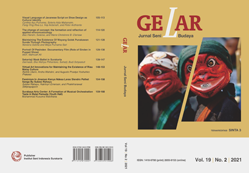Sekartaji Mask Ballet in Surakarta
Main Article Content
Abstract
ABSTRAK
Sendratari Topeng Sekartaji merupakan tari tradisi garapan baru yang diilhami oleh Serat Panji yang ditulis pada Jaman Jenggala Kediri abad XI-XII. Tujuan penelitian Sendratari Topeng Sekartaji adalah untuk menggali kreativitas tari di sekitar Surakarta serta menemukan bentuk dan elemen-elemen pendukungnya. Metode penelitian yang digunakan meliputi pengumpulan data dengan tekhnik observasi, wawancara dan dokumentasi. Pengolahan data dilakukan dengan tekhnik analisis bentuk dan struktur. Evaluasi validitas data dengan tekhnik trianggulasi. Penelitian menggunakan pendekatan antropologi seni yang beranggapan bahwa karya seni merupakan ekspresi karya seniman. Hasil penelitian menunjukan Sendratari Topeng Sekartaji merupakan karya tari kelompok bertema percintaan sebagai ungkapan kreativitas seni yang popular pada zaman akhir orde lama dan awal orde baru. Sendratari dalam kurun waktu, dipentaskan dengan berbagai variasi sesuai dengan pendukung, situasi dan kondisi serta waktu yang disediakan. Bentuk kreativitas seni dapat berupa frahmen, pethilan, tari tunggal dan yang paling utama adalah sendratari. Tata urutan sajian tergantung pada bentuk pertunjukanya. Gerak tari pada tokoh antagonis berupa gagahan gaya Surakarta, tokoh protagonis dengan alus luruh, sedang tari putri dengan putri luruh. Pada akhir pertunjukan selalu bermuara kepada keberhasilan hubungan cinta kasih.
Kunci: sendratari, topeng, sekartaji, Surakarta.
ABSTRACT
This research entitled “Sendratari Topeng Sekartaji” proposed exploring dance creativity in Surakarta and finding its formats and support elements. This research used data collection with techniques such as observation, interview and documentation as the research method. Data is processed by the technique of format and structure analysis. The technique of triangulation is used as a technique to evaluate data. This research used an art anthropological approach. It is assumed that an artwork is an expression of an artist’s work. Research results showed that Sendratari Topeng Sekartaji is a colossal dance with a romance theme. It was a representation of artwork that has been popularized since the end of the old order and early new order. During that time, sendratari has presented narratively, according to situation, condition and support elements. Art creativity manifested into fragment “pethilan”, single dance and especially “sendratari”. Its arrangement for presentation depends on its performance format. They have “gagahan” in Surakarta style for their dance moves, “alus luruh” and “putri lurah” for antagonist, protagonist, and female dance, irrespectively. The last performance always refers to romantic relationship successfully.
Keywords:Sendratari Topeng; Sekartaji; Mask balet
Downloads
Article Details
Copyright
Authors who publish with Gelar: Jurnal Seni Budaya agrees to the following terms:
- Authors retain copyright and grant the journal right of first publication with the work simultaneously licensed under a Creative Commons Attribution License (CC BY-SA 4.0) that allows others to share the work with an acknowledgment of the work's authorship and initial publication in this journal.
- Authors are able to enter into separate, additional contractual arrangements for the non-exclusive distribution of the journal's published version of the work (e.g., post it to an institutional repository or publish it in a book), with an acknowledgment of its initial publication in this journal.
- Authors are permitted and encouraged to post their work online (e.g., in institutional repositories or on their website) prior to and during the submission process, as it can lead to productive exchanges, as well as earlier and greater citation of published work.
References
Guillot, Claude, and Jean Couteau. 2020. “The Tembayat Hill: Clergy and Royal Power in Central Java from the 15th to the 17th Century.” In The Potent Dead, 141–59. Routledge.
Kamtoni, Yoga Ardanu Kifson Giyar, and Nanik Sri Prihatini. 2020. “The Existence of Sedap Malam Community and Its Form of Performance as a Cross Gender Dance Group in Sragen East Java.”
Kieven, Lydia. 2020. “Panji and Sekartaji on the Move.” Wacana 21 (1): 69–102.
Kumar, Ann. 2020. “Panji in Javanese Court Literature and Beyond.” Wacana 21 (1): 135–55.
Lazer, David, Eszter Hargittai, Deen Freelon, Sandra Gonzalez-Bailon, Kevin Munger, Katherine Ognyanova, and Jason Radford. 2021. “Meaningful Measures of Human Society in the Twenty-First Century.” Nature 595 (7866): 189–96.
Minarto, Soerjo Wido, and Kelik Desta Rahmanto. 2020. “Topeng Patih Dance: A Manifestation of the Beginning of Human Life in the Malang Mask Puppet’s World.” KnE Social Sciences, 456–69.
Nielsen, Bo Bernhard, Catherine Welch, Agnieszka Chidlow, Stewart Robert Miller, Roberta Aguzzoli, Emma Gardner, Maria Karafyllia, and Diletta Pegoraro. 2020. “Fifty Years of Methodological Trends in JIBS: Why Future IB Research Needs More Triangulation.” Journal of International Business Studies 51 (9): 1478–99.
Sulton, Sulton, Betty Yulia Wulansari, and Prihma Sinta Utami. 2020. “Wayang Golek Reog Ponorogo: The Acculturation of Indonesian Culture As Patriotism Character Education Learning Medium to Early Age Children.”
Sunarto, Bambang. 2020. “Returning to Tri Hita Karana in Bali, Indonesia: Setem’s Paradigm in the Creation of an Environmental Art.” Discourse.
Tayibnapis, Radita Gora, Tarsani Tarsani, and Risqi Inayah Dwijayanti. 2020. “The Dynamics of Communication on the Identity Crisis of Malangan Mask Art in the Cultural Adaptation of Malang People.” International Journal of Multicultural and Multireligious Understanding 7 (10): 364–77.
Vickers, Adrian. 2020. “Reconstructing the History of Panji Performances in Southeast Asia.” Wacana 21 (2): 268–84.
Wibowo, Muhammad Widya Ari, and Kuswarsantyo1 Cholis Mahardika. 2020. “The Existence of Panji Masks in Postmodern.”
